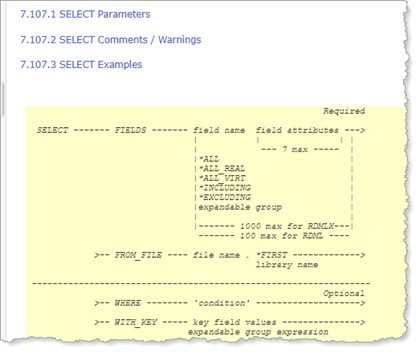
RDML code syntax is:
Command Parm1() Parm2() Parm3()
A command has one or more required parameters. Parameters with a default value are not shown in the editor.
In your source code all variables, fields and component names must be written beginning with a # (hash).
The editor recognizes required parameters. For example, the SELECT / ENDSELECT loop command reads a group of records from a database table. It has required parameters Fields() and From_File(). A SELECT command could be written like this:
Select #xEmployeeSurname xEmployee
Moving to the next line, the editor completes this code as follows:
Select Fields(#xEmployeeSurname) From_File(xEmployee)
Endselect
Note that this SELECT example will read all records from the table xEmployee. A more typical example would look like this:
Select Fields(#xEmployeeIdentification
#xEmployeeSurname) From_File(xEmployeebyDepartment)
With_Key(#xEmployeeDepartment)
This uses an Index and returns all employees with the specified department code (xEmployeeDepartment).
To find full details for a command, select the command in the editor and press F1 to open its entry in the Technical Reference guide. For each command you will find command:
•Parameters
•Comments / Warnings
•Examples

For more information see LANSA RDML in the Developer guide.
Also see RDML Commands in the Technical Reference guide.